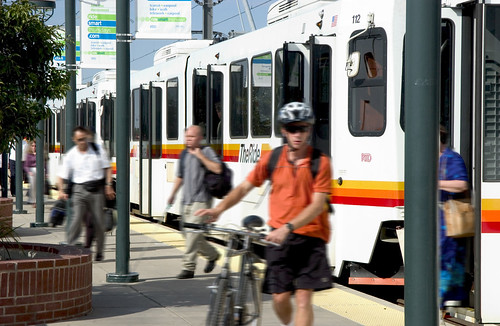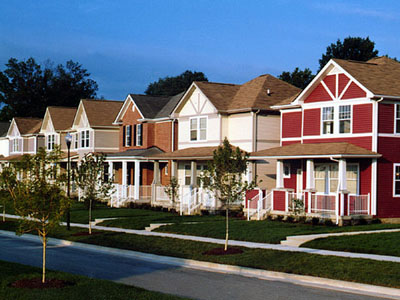The Obama administration’s remarkable week on sustainable cities, smart growth and revitalization

Posted July 16, 2009 at 1:35PM
Wow. On Monday, before heading out to toss the first pitch at Tuesday's baseball All-Star Game, the president kicked off a White House forum on urban policy by criticizing past federal measures that have encouraged sprawl and promising a new look at ways, including support for public transit, to help metropolitan (in other words, not just traditionally "urban") areas become more sustainable.
From a story by Robin Shulman in The Washington Post, here are some highlights:
"Addressing a White House urban affairs summit on Monday, President Obama called for the 'reinvention' of America's cities and metropolitan areas and vowed to spark a public conversation to create a 'new, imaginative, bold vision' for urban policy . . .
"Obama noted that he has lived almost all his life in cities, including studying in Los Angeles, New York and Cambridge, Mass., and founding his political career in Chicago.
But he said that he defined 'urban' as not just inner cities, but also their surrounding suburbs, asserting that there is no longer a divide between the two . . .
"He said he would send members of his Cabinet and the Office of Urban Affairs to look at innovations in cities around the country to elevate as best practices.
"Obama noted Denver, for its plans to build a public transit system to handle the city's anticipated growth; Philadelphia, for its urban agriculture; and Kansas City, which has weatherized homes and built a ecologically minded transit system in one low-income neighborhood . . .
"'For too long, federal policy has actually encouraged sprawl and congestion and pollution, rather than quality public transportation and smart, sustainable development,' said Obama.
"He said that developing housing, transportation and energy-efficiency should 'go hand in hand.'"
The president more than once invoked the new HUD/DOT/EPA partnership on sustainability (that I reported here and here), as well as several White House offices, including the new Office of Urban Affairs. These themes were a big part of his presidential campaign as well.
Then, Tuesday morning, Transportation Secretary Ray LaHood put a little policy meat on the rhetorical bones in testimony before the Senate Committee on Environment and Public Works. His message was all about reducing transportation-related greenhouse gas emissions not just through more efficient vehicles but also through walkable, mixed-income communities near public transit. The Secretary summarized his remarks in his blog on Tuesday:
- "We must implement policies and programs that reduce vehicle miles driven.
- "This means providing communities with additional transportation choices, such as light rail, fuel-efficient buses, and paths for pedestrians and bicycles that intersect with transit centers.
 These options will also reduce household transportation costs, strengthen local economies, lower traffic congestion, and reduce reliance on foreign oil.
These options will also reduce household transportation costs, strengthen local economies, lower traffic congestion, and reduce reliance on foreign oil. - "Our strategy also calls for investing transportation dollars in coordination with housing and economic development. By doing so, we can promote strong communities with mixed-income housing located close to transit in walkable neighborhoods."
By Tuesday afternoon, it was the turn of housing secretary Shaun Donovan, who spoke along with former HUD secretary Henry Cisneros at an event hosted by the Brookings Institution. Brookings was honoring the innovative federal HOPE VI program to replace dilapidated public housing with mixed-income, human-scaled neighborhoods, and a new book by Cisneros about the program. (Seattle's High Point neighborhood, featured in our green infrastructure slideshow earlier this week, is a HOPE VI development and was mentioned in Donovan's remarks.) I was supposed to attend but, regrettably, got caught up in an important meeting at NRDC and had to miss it.
Donovan wants to expand on HOPE VI through a new program the Administration calls Choice Neighborhoods. The initiative is being designed to do what HOPE VI has done in sponsoring affordable housing in the context of real neighborhoods, but also to go further to make the local initiatives even more community-oriented with supplemental assistance for jobs and education to help break the cycle of poverty. Again, here are some excerpts, this time from Secretary Donovan's remarks:
"Our FY 2010 budget request for Choice Neighborhoods would be $250 million - more than double the funding we have for HOPE VI this year.
"But a HOPE VI development that is surrounded by disinvestment, by failing schools or by other distressed housing has virtually no chance of truly succeeding.
"That's what Choice Neighborhoods is all about. It would expand on the legacy of HOPE VI by expanding the range of activities eligible for funding and capitalize on the full range of stakeholders we know are needed and want to be involved - from local governments and non-profits to private firms and public housing agencies.
"And like the successful Jobs Plus Demonstration, residents in public and assisted housing would be eligible to receive work incentives and work supports.
"Choice Neighborhoods would also link housing interventions more closely with intensive school reform and early childhood innovations. Critically, the Department of Education is standing shoulder-to-shoulder with us in this effort with its new Promise Neighborhoods initiative . . .
"Combined with HUD's Sustainable Communities Initiative to bring transportation and housing planning together at the local level to reduce costs and increase opportunities for working families, we believe Choice Neighborhoods has the potential to revitalize and transform communities across the country."
I have to quote just one more passage, from the concluding portion of Donovan's remarks, that is near and dear to my heart:
"Whether we live in a city or in the Great American Heartland, every American has a stake in urban revitalization and neighborhood transformation.
"Today, America's cities and surrounding communities are increasingly becoming the engine of our nation's economic growth. Ninety cents of every dollar in our economy is generated by our metropolitan areas. These same communities house more than two-thirds of our population . . .
"And if sixteen years of HOPE VI has taught us anything, it's that building communities in a more integrated and inclusive way isn't separate from advancing social and economic justice and the promise of America - it's absolutely essential to it.
It's inseparable from the idea that, in America, our hopes and our dreams should never be limited by where we live-an idea that, as we speak, Judge Sotomayor - a product of America's public housing - is on Capitol Hill proving to the world."
I won't pretend to be the equal of Justice-to-be Sotomayor on anything, but having lived in public housing is something she and I have in common (if only briefly in my case). That's just one of many reasons I'm rooting hard for these new initiatives to succeed. Mostly, I just find it utterly remarkable that the federal government finally gets it about the "triple bottom line" (equity, environment, economy) of sustainable development, and they get it about cities and metro areas, too. A lot needs to be done, but that's a great start for the issues that readers of blogs like this care about.
